Business Strategy for Tesla
VerifiedAdded on 2022/12/27
|19
|4899
|63
AI Summary
This report discusses the formulation of business strategy for Tesla, including understanding vision and mission, impact of macro-environmental factors, stakeholders analysis, internal environment assessment, and strategic planning.
Contribute Materials
Your contribution can guide someone’s learning journey. Share your
documents today.
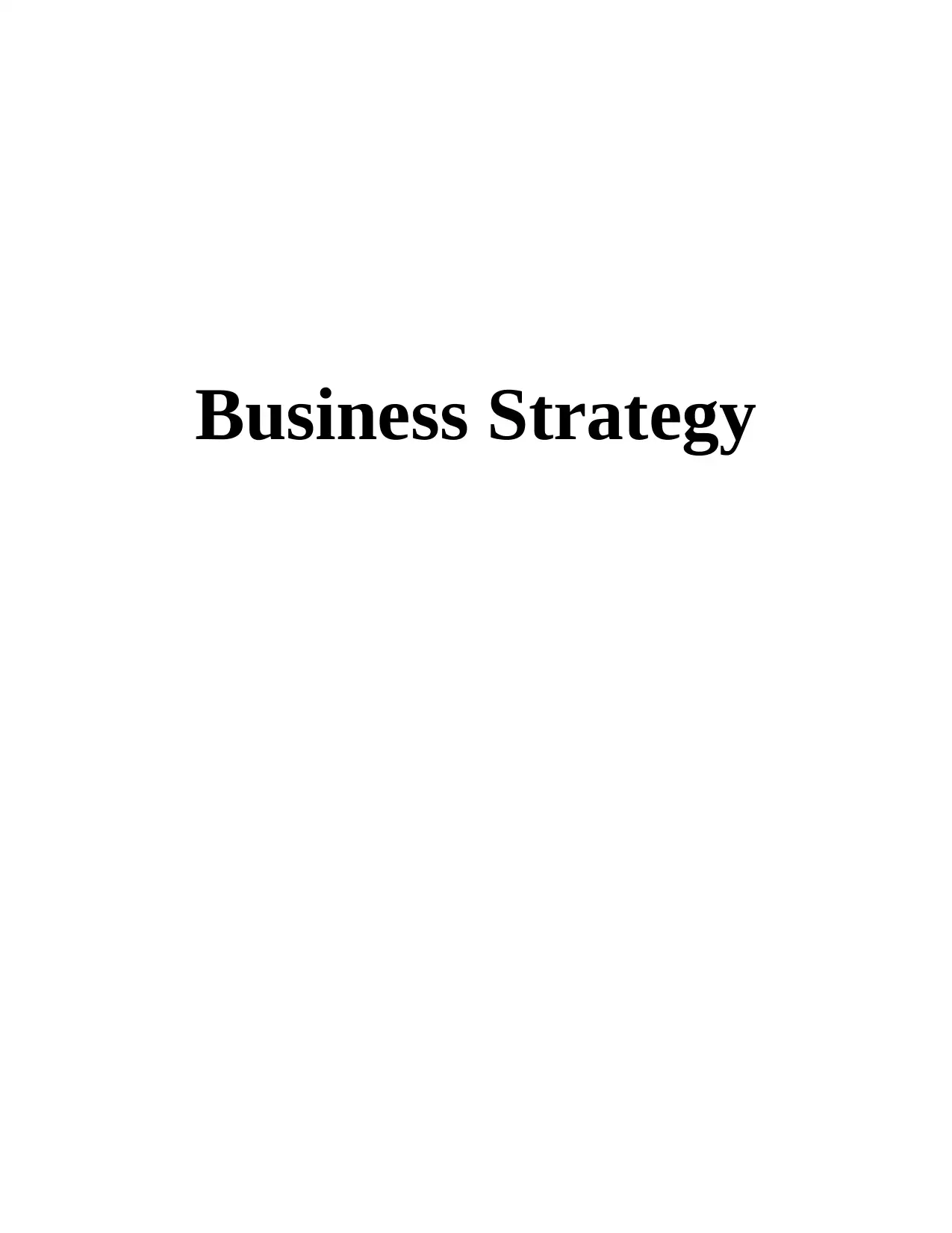
Business Strategy
Secure Best Marks with AI Grader
Need help grading? Try our AI Grader for instant feedback on your assignments.
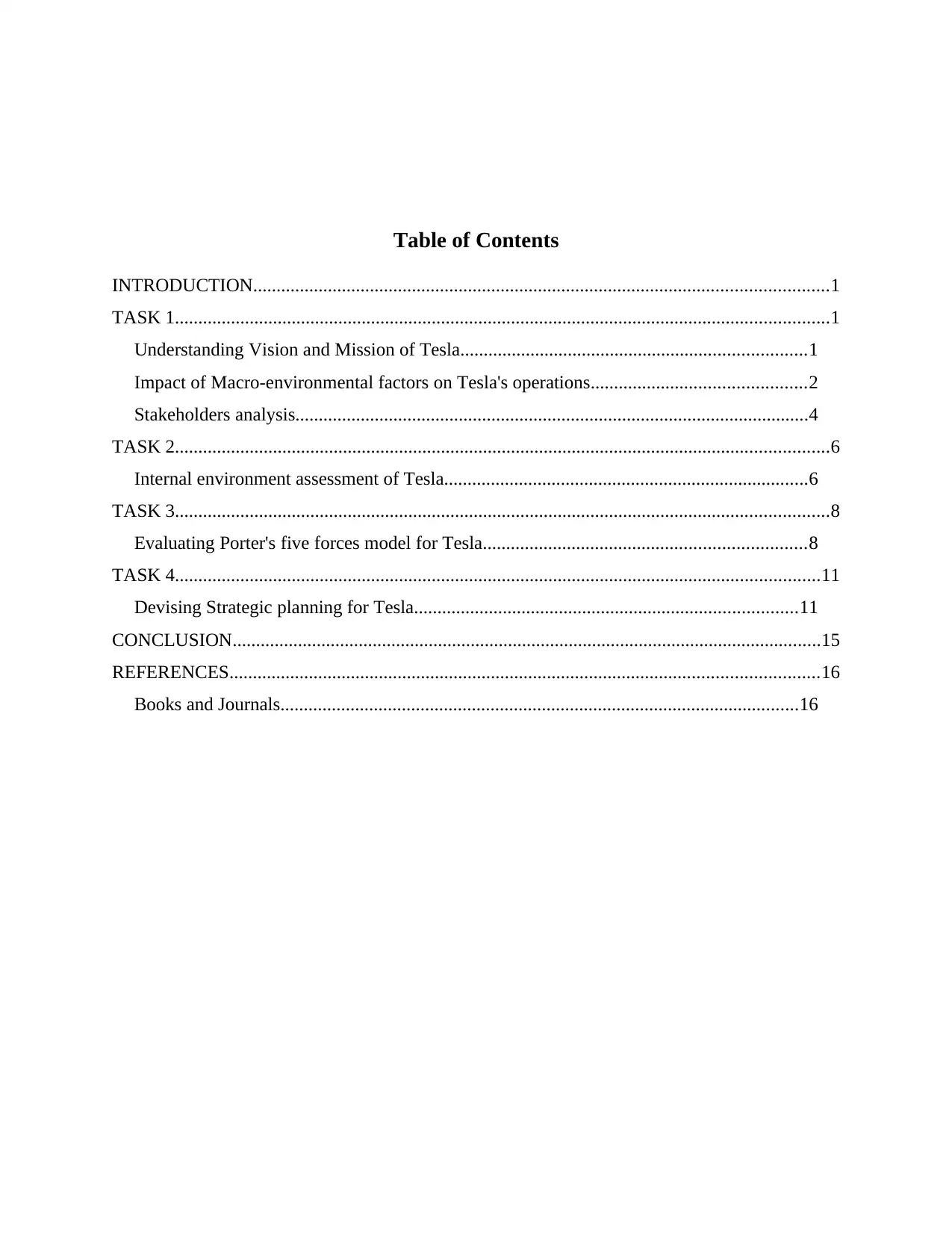
Table of Contents
INTRODUCTION...........................................................................................................................1
TASK 1............................................................................................................................................1
Understanding Vision and Mission of Tesla..........................................................................1
Impact of Macro-environmental factors on Tesla's operations..............................................2
Stakeholders analysis..............................................................................................................4
TASK 2............................................................................................................................................6
Internal environment assessment of Tesla..............................................................................6
TASK 3............................................................................................................................................8
Evaluating Porter's five forces model for Tesla.....................................................................8
TASK 4..........................................................................................................................................11
Devising Strategic planning for Tesla..................................................................................11
CONCLUSION..............................................................................................................................15
REFERENCES..............................................................................................................................16
Books and Journals...............................................................................................................16
INTRODUCTION...........................................................................................................................1
TASK 1............................................................................................................................................1
Understanding Vision and Mission of Tesla..........................................................................1
Impact of Macro-environmental factors on Tesla's operations..............................................2
Stakeholders analysis..............................................................................................................4
TASK 2............................................................................................................................................6
Internal environment assessment of Tesla..............................................................................6
TASK 3............................................................................................................................................8
Evaluating Porter's five forces model for Tesla.....................................................................8
TASK 4..........................................................................................................................................11
Devising Strategic planning for Tesla..................................................................................11
CONCLUSION..............................................................................................................................15
REFERENCES..............................................................................................................................16
Books and Journals...............................................................................................................16

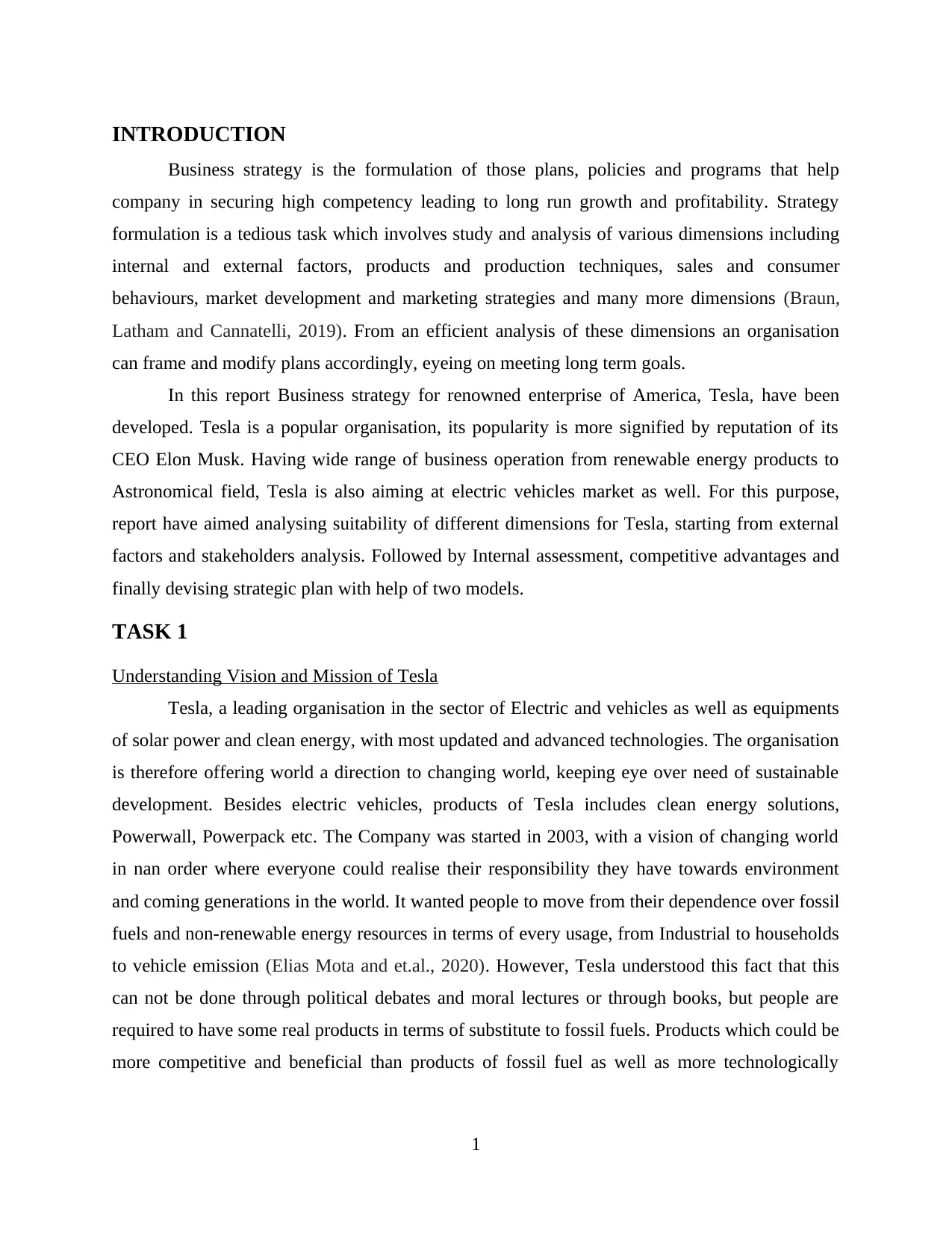
INTRODUCTION
Business strategy is the formulation of those plans, policies and programs that help
company in securing high competency leading to long run growth and profitability. Strategy
formulation is a tedious task which involves study and analysis of various dimensions including
internal and external factors, products and production techniques, sales and consumer
behaviours, market development and marketing strategies and many more dimensions (Braun,
Latham and Cannatelli, 2019). From an efficient analysis of these dimensions an organisation
can frame and modify plans accordingly, eyeing on meeting long term goals.
In this report Business strategy for renowned enterprise of America, Tesla, have been
developed. Tesla is a popular organisation, its popularity is more signified by reputation of its
CEO Elon Musk. Having wide range of business operation from renewable energy products to
Astronomical field, Tesla is also aiming at electric vehicles market as well. For this purpose,
report have aimed analysing suitability of different dimensions for Tesla, starting from external
factors and stakeholders analysis. Followed by Internal assessment, competitive advantages and
finally devising strategic plan with help of two models.
TASK 1
Understanding Vision and Mission of Tesla
Tesla, a leading organisation in the sector of Electric and vehicles as well as equipments
of solar power and clean energy, with most updated and advanced technologies. The organisation
is therefore offering world a direction to changing world, keeping eye over need of sustainable
development. Besides electric vehicles, products of Tesla includes clean energy solutions,
Powerwall, Powerpack etc. The Company was started in 2003, with a vision of changing world
in nan order where everyone could realise their responsibility they have towards environment
and coming generations in the world. It wanted people to move from their dependence over fossil
fuels and non-renewable energy resources in terms of every usage, from Industrial to households
to vehicle emission (Elias Mota and et.al., 2020). However, Tesla understood this fact that this
can not be done through political debates and moral lectures or through books, but people are
required to have some real products in terms of substitute to fossil fuels. Products which could be
more competitive and beneficial than products of fossil fuel as well as more technologically
1
Business strategy is the formulation of those plans, policies and programs that help
company in securing high competency leading to long run growth and profitability. Strategy
formulation is a tedious task which involves study and analysis of various dimensions including
internal and external factors, products and production techniques, sales and consumer
behaviours, market development and marketing strategies and many more dimensions (Braun,
Latham and Cannatelli, 2019). From an efficient analysis of these dimensions an organisation
can frame and modify plans accordingly, eyeing on meeting long term goals.
In this report Business strategy for renowned enterprise of America, Tesla, have been
developed. Tesla is a popular organisation, its popularity is more signified by reputation of its
CEO Elon Musk. Having wide range of business operation from renewable energy products to
Astronomical field, Tesla is also aiming at electric vehicles market as well. For this purpose,
report have aimed analysing suitability of different dimensions for Tesla, starting from external
factors and stakeholders analysis. Followed by Internal assessment, competitive advantages and
finally devising strategic plan with help of two models.
TASK 1
Understanding Vision and Mission of Tesla
Tesla, a leading organisation in the sector of Electric and vehicles as well as equipments
of solar power and clean energy, with most updated and advanced technologies. The organisation
is therefore offering world a direction to changing world, keeping eye over need of sustainable
development. Besides electric vehicles, products of Tesla includes clean energy solutions,
Powerwall, Powerpack etc. The Company was started in 2003, with a vision of changing world
in nan order where everyone could realise their responsibility they have towards environment
and coming generations in the world. It wanted people to move from their dependence over fossil
fuels and non-renewable energy resources in terms of every usage, from Industrial to households
to vehicle emission (Elias Mota and et.al., 2020). However, Tesla understood this fact that this
can not be done through political debates and moral lectures or through books, but people are
required to have some real products in terms of substitute to fossil fuels. Products which could be
more competitive and beneficial than products of fossil fuel as well as more technologically
1
Secure Best Marks with AI Grader
Need help grading? Try our AI Grader for instant feedback on your assignments.
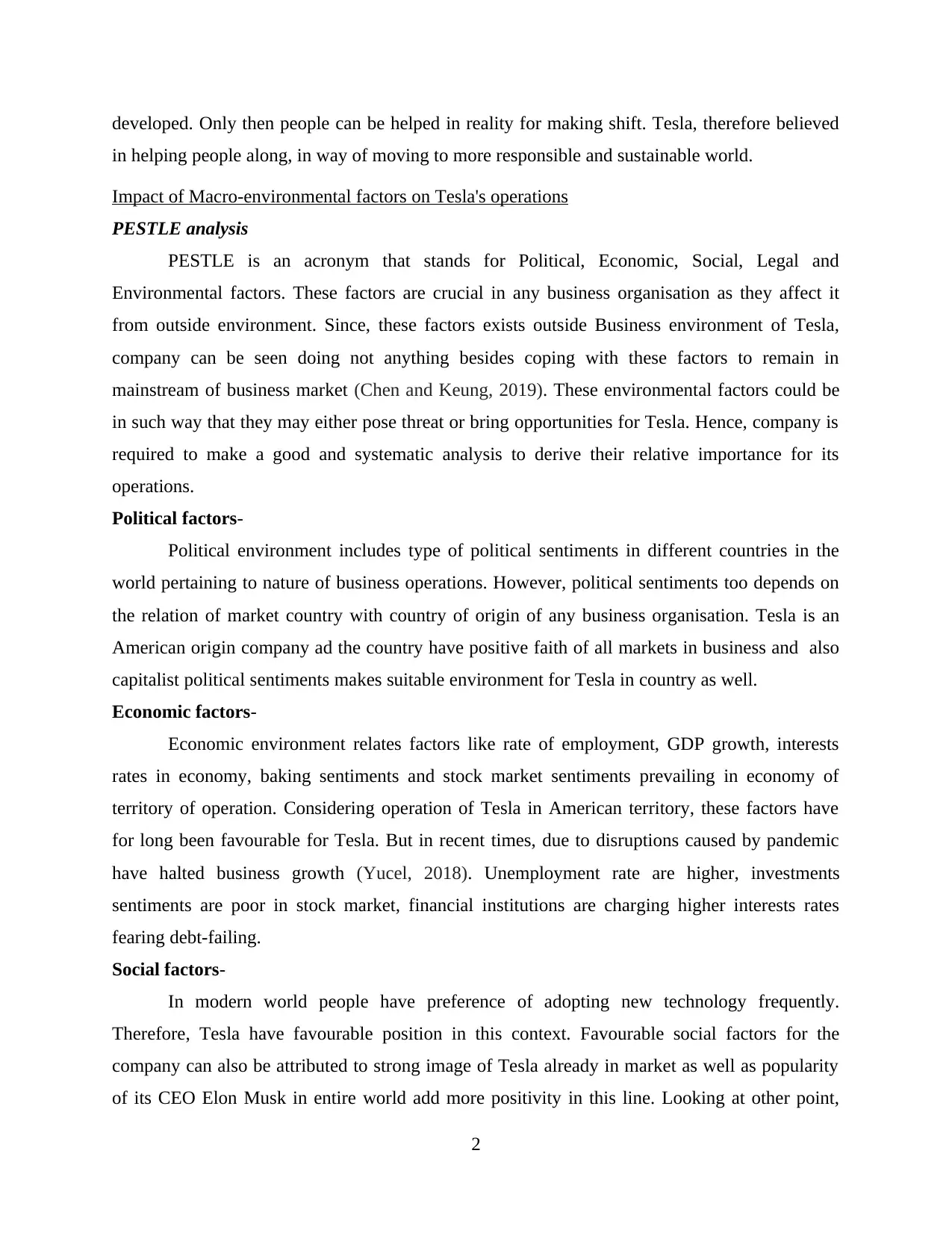
developed. Only then people can be helped in reality for making shift. Tesla, therefore believed
in helping people along, in way of moving to more responsible and sustainable world.
Impact of Macro-environmental factors on Tesla's operations
PESTLE analysis
PESTLE is an acronym that stands for Political, Economic, Social, Legal and
Environmental factors. These factors are crucial in any business organisation as they affect it
from outside environment. Since, these factors exists outside Business environment of Tesla,
company can be seen doing not anything besides coping with these factors to remain in
mainstream of business market (Chen and Keung, 2019). These environmental factors could be
in such way that they may either pose threat or bring opportunities for Tesla. Hence, company is
required to make a good and systematic analysis to derive their relative importance for its
operations.
Political factors-
Political environment includes type of political sentiments in different countries in the
world pertaining to nature of business operations. However, political sentiments too depends on
the relation of market country with country of origin of any business organisation. Tesla is an
American origin company ad the country have positive faith of all markets in business and also
capitalist political sentiments makes suitable environment for Tesla in country as well.
Economic factors-
Economic environment relates factors like rate of employment, GDP growth, interests
rates in economy, baking sentiments and stock market sentiments prevailing in economy of
territory of operation. Considering operation of Tesla in American territory, these factors have
for long been favourable for Tesla. But in recent times, due to disruptions caused by pandemic
have halted business growth (Yucel, 2018). Unemployment rate are higher, investments
sentiments are poor in stock market, financial institutions are charging higher interests rates
fearing debt-failing.
Social factors-
In modern world people have preference of adopting new technology frequently.
Therefore, Tesla have favourable position in this context. Favourable social factors for the
company can also be attributed to strong image of Tesla already in market as well as popularity
of its CEO Elon Musk in entire world add more positivity in this line. Looking at other point,
2
in helping people along, in way of moving to more responsible and sustainable world.
Impact of Macro-environmental factors on Tesla's operations
PESTLE analysis
PESTLE is an acronym that stands for Political, Economic, Social, Legal and
Environmental factors. These factors are crucial in any business organisation as they affect it
from outside environment. Since, these factors exists outside Business environment of Tesla,
company can be seen doing not anything besides coping with these factors to remain in
mainstream of business market (Chen and Keung, 2019). These environmental factors could be
in such way that they may either pose threat or bring opportunities for Tesla. Hence, company is
required to make a good and systematic analysis to derive their relative importance for its
operations.
Political factors-
Political environment includes type of political sentiments in different countries in the
world pertaining to nature of business operations. However, political sentiments too depends on
the relation of market country with country of origin of any business organisation. Tesla is an
American origin company ad the country have positive faith of all markets in business and also
capitalist political sentiments makes suitable environment for Tesla in country as well.
Economic factors-
Economic environment relates factors like rate of employment, GDP growth, interests
rates in economy, baking sentiments and stock market sentiments prevailing in economy of
territory of operation. Considering operation of Tesla in American territory, these factors have
for long been favourable for Tesla. But in recent times, due to disruptions caused by pandemic
have halted business growth (Yucel, 2018). Unemployment rate are higher, investments
sentiments are poor in stock market, financial institutions are charging higher interests rates
fearing debt-failing.
Social factors-
In modern world people have preference of adopting new technology frequently.
Therefore, Tesla have favourable position in this context. Favourable social factors for the
company can also be attributed to strong image of Tesla already in market as well as popularity
of its CEO Elon Musk in entire world add more positivity in this line. Looking at other point,
2
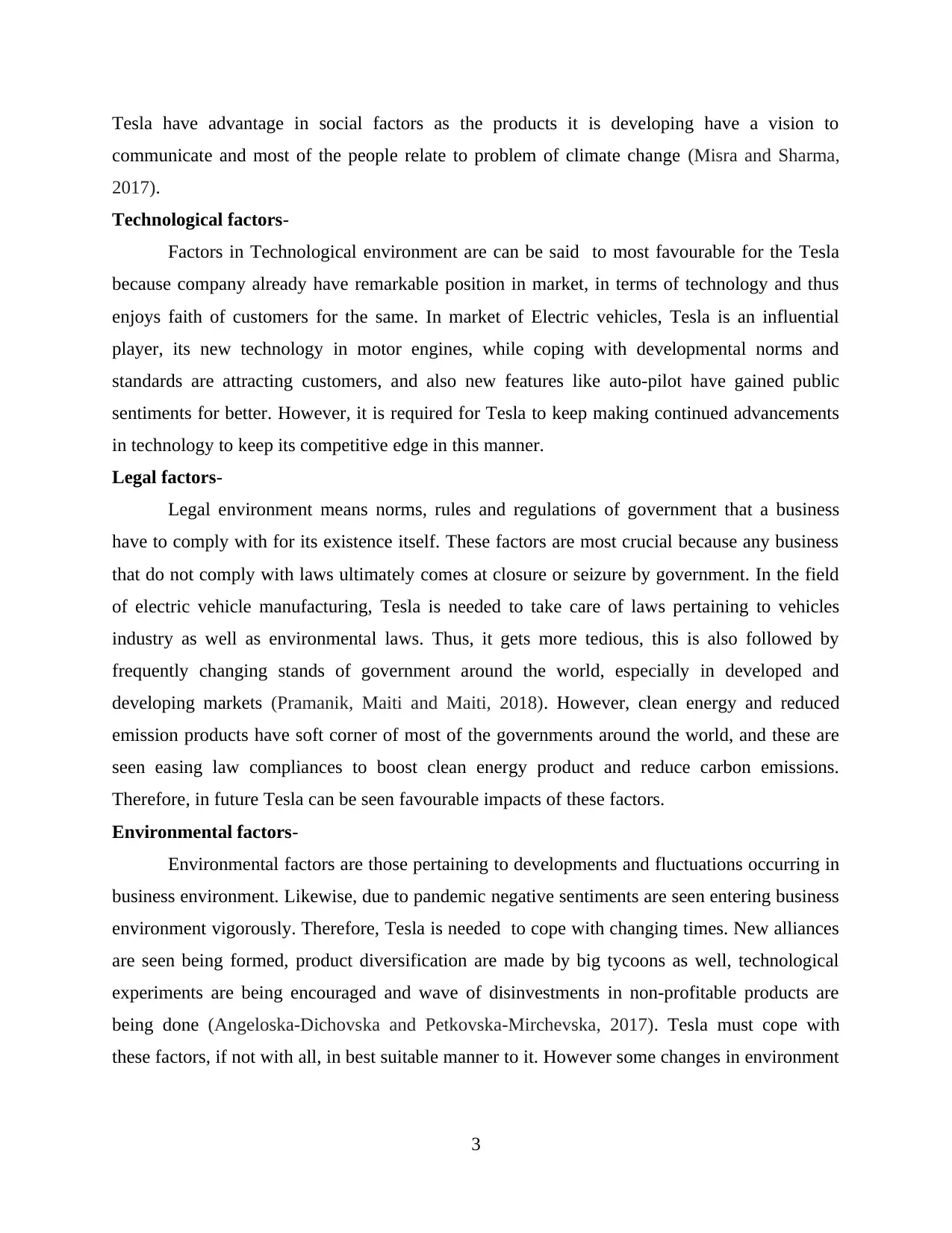
Tesla have advantage in social factors as the products it is developing have a vision to
communicate and most of the people relate to problem of climate change (Misra and Sharma,
2017).
Technological factors-
Factors in Technological environment are can be said to most favourable for the Tesla
because company already have remarkable position in market, in terms of technology and thus
enjoys faith of customers for the same. In market of Electric vehicles, Tesla is an influential
player, its new technology in motor engines, while coping with developmental norms and
standards are attracting customers, and also new features like auto-pilot have gained public
sentiments for better. However, it is required for Tesla to keep making continued advancements
in technology to keep its competitive edge in this manner.
Legal factors-
Legal environment means norms, rules and regulations of government that a business
have to comply with for its existence itself. These factors are most crucial because any business
that do not comply with laws ultimately comes at closure or seizure by government. In the field
of electric vehicle manufacturing, Tesla is needed to take care of laws pertaining to vehicles
industry as well as environmental laws. Thus, it gets more tedious, this is also followed by
frequently changing stands of government around the world, especially in developed and
developing markets (Pramanik, Maiti and Maiti, 2018). However, clean energy and reduced
emission products have soft corner of most of the governments around the world, and these are
seen easing law compliances to boost clean energy product and reduce carbon emissions.
Therefore, in future Tesla can be seen favourable impacts of these factors.
Environmental factors-
Environmental factors are those pertaining to developments and fluctuations occurring in
business environment. Likewise, due to pandemic negative sentiments are seen entering business
environment vigorously. Therefore, Tesla is needed to cope with changing times. New alliances
are seen being formed, product diversification are made by big tycoons as well, technological
experiments are being encouraged and wave of disinvestments in non-profitable products are
being done (Angeloska-Dichovska and Petkovska-Mirchevska, 2017). Tesla must cope with
these factors, if not with all, in best suitable manner to it. However some changes in environment
3
communicate and most of the people relate to problem of climate change (Misra and Sharma,
2017).
Technological factors-
Factors in Technological environment are can be said to most favourable for the Tesla
because company already have remarkable position in market, in terms of technology and thus
enjoys faith of customers for the same. In market of Electric vehicles, Tesla is an influential
player, its new technology in motor engines, while coping with developmental norms and
standards are attracting customers, and also new features like auto-pilot have gained public
sentiments for better. However, it is required for Tesla to keep making continued advancements
in technology to keep its competitive edge in this manner.
Legal factors-
Legal environment means norms, rules and regulations of government that a business
have to comply with for its existence itself. These factors are most crucial because any business
that do not comply with laws ultimately comes at closure or seizure by government. In the field
of electric vehicle manufacturing, Tesla is needed to take care of laws pertaining to vehicles
industry as well as environmental laws. Thus, it gets more tedious, this is also followed by
frequently changing stands of government around the world, especially in developed and
developing markets (Pramanik, Maiti and Maiti, 2018). However, clean energy and reduced
emission products have soft corner of most of the governments around the world, and these are
seen easing law compliances to boost clean energy product and reduce carbon emissions.
Therefore, in future Tesla can be seen favourable impacts of these factors.
Environmental factors-
Environmental factors are those pertaining to developments and fluctuations occurring in
business environment. Likewise, due to pandemic negative sentiments are seen entering business
environment vigorously. Therefore, Tesla is needed to cope with changing times. New alliances
are seen being formed, product diversification are made by big tycoons as well, technological
experiments are being encouraged and wave of disinvestments in non-profitable products are
being done (Angeloska-Dichovska and Petkovska-Mirchevska, 2017). Tesla must cope with
these factors, if not with all, in best suitable manner to it. However some changes in environment
3
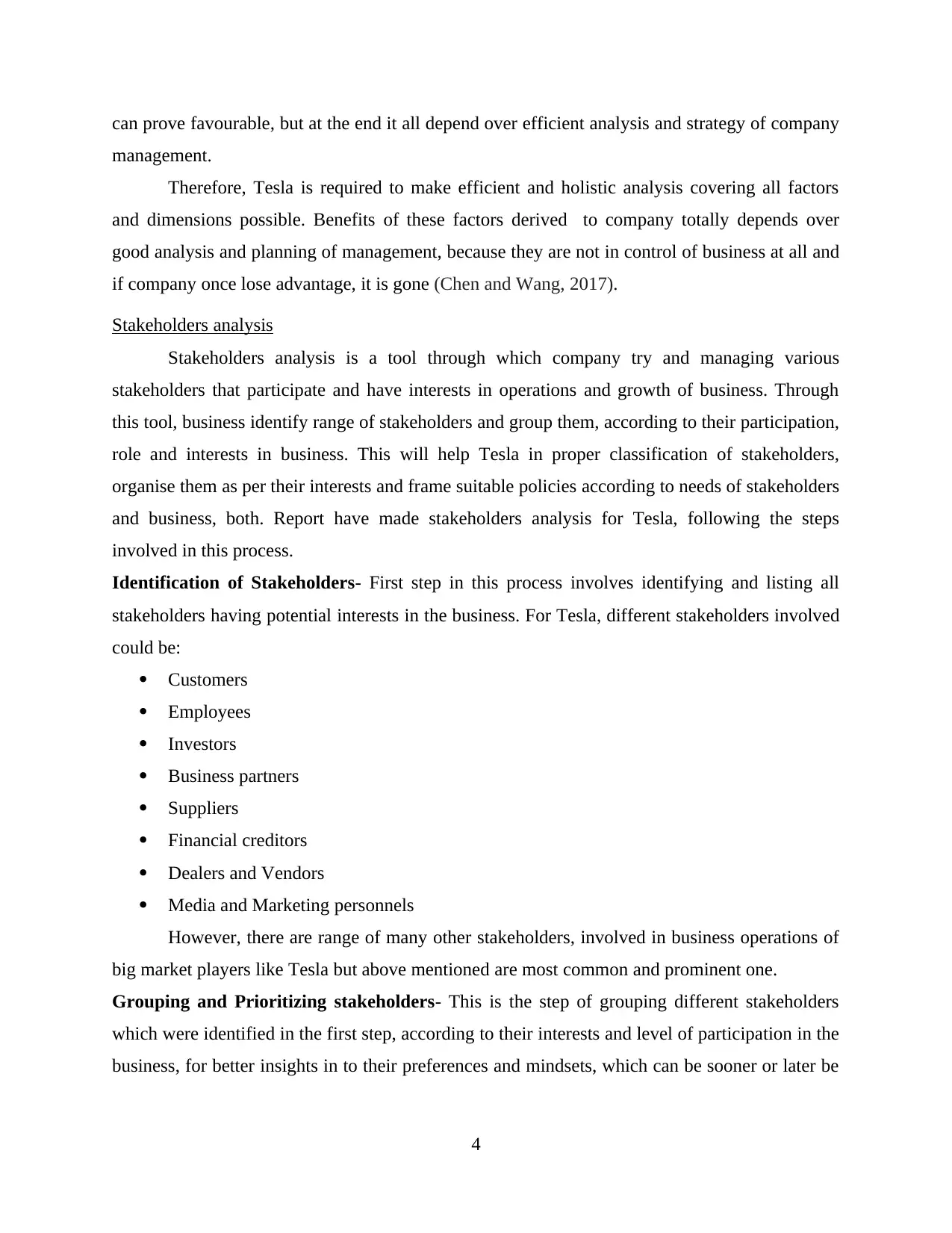
can prove favourable, but at the end it all depend over efficient analysis and strategy of company
management.
Therefore, Tesla is required to make efficient and holistic analysis covering all factors
and dimensions possible. Benefits of these factors derived to company totally depends over
good analysis and planning of management, because they are not in control of business at all and
if company once lose advantage, it is gone (Chen and Wang, 2017).
Stakeholders analysis
Stakeholders analysis is a tool through which company try and managing various
stakeholders that participate and have interests in operations and growth of business. Through
this tool, business identify range of stakeholders and group them, according to their participation,
role and interests in business. This will help Tesla in proper classification of stakeholders,
organise them as per their interests and frame suitable policies according to needs of stakeholders
and business, both. Report have made stakeholders analysis for Tesla, following the steps
involved in this process.
Identification of Stakeholders- First step in this process involves identifying and listing all
stakeholders having potential interests in the business. For Tesla, different stakeholders involved
could be:
Customers
Employees
Investors
Business partners
Suppliers
Financial creditors
Dealers and Vendors
Media and Marketing personnels
However, there are range of many other stakeholders, involved in business operations of
big market players like Tesla but above mentioned are most common and prominent one.
Grouping and Prioritizing stakeholders- This is the step of grouping different stakeholders
which were identified in the first step, according to their interests and level of participation in the
business, for better insights in to their preferences and mindsets, which can be sooner or later be
4
management.
Therefore, Tesla is required to make efficient and holistic analysis covering all factors
and dimensions possible. Benefits of these factors derived to company totally depends over
good analysis and planning of management, because they are not in control of business at all and
if company once lose advantage, it is gone (Chen and Wang, 2017).
Stakeholders analysis
Stakeholders analysis is a tool through which company try and managing various
stakeholders that participate and have interests in operations and growth of business. Through
this tool, business identify range of stakeholders and group them, according to their participation,
role and interests in business. This will help Tesla in proper classification of stakeholders,
organise them as per their interests and frame suitable policies according to needs of stakeholders
and business, both. Report have made stakeholders analysis for Tesla, following the steps
involved in this process.
Identification of Stakeholders- First step in this process involves identifying and listing all
stakeholders having potential interests in the business. For Tesla, different stakeholders involved
could be:
Customers
Employees
Investors
Business partners
Suppliers
Financial creditors
Dealers and Vendors
Media and Marketing personnels
However, there are range of many other stakeholders, involved in business operations of
big market players like Tesla but above mentioned are most common and prominent one.
Grouping and Prioritizing stakeholders- This is the step of grouping different stakeholders
which were identified in the first step, according to their interests and level of participation in the
business, for better insights in to their preferences and mindsets, which can be sooner or later be
4
Paraphrase This Document
Need a fresh take? Get an instant paraphrase of this document with our AI Paraphraser
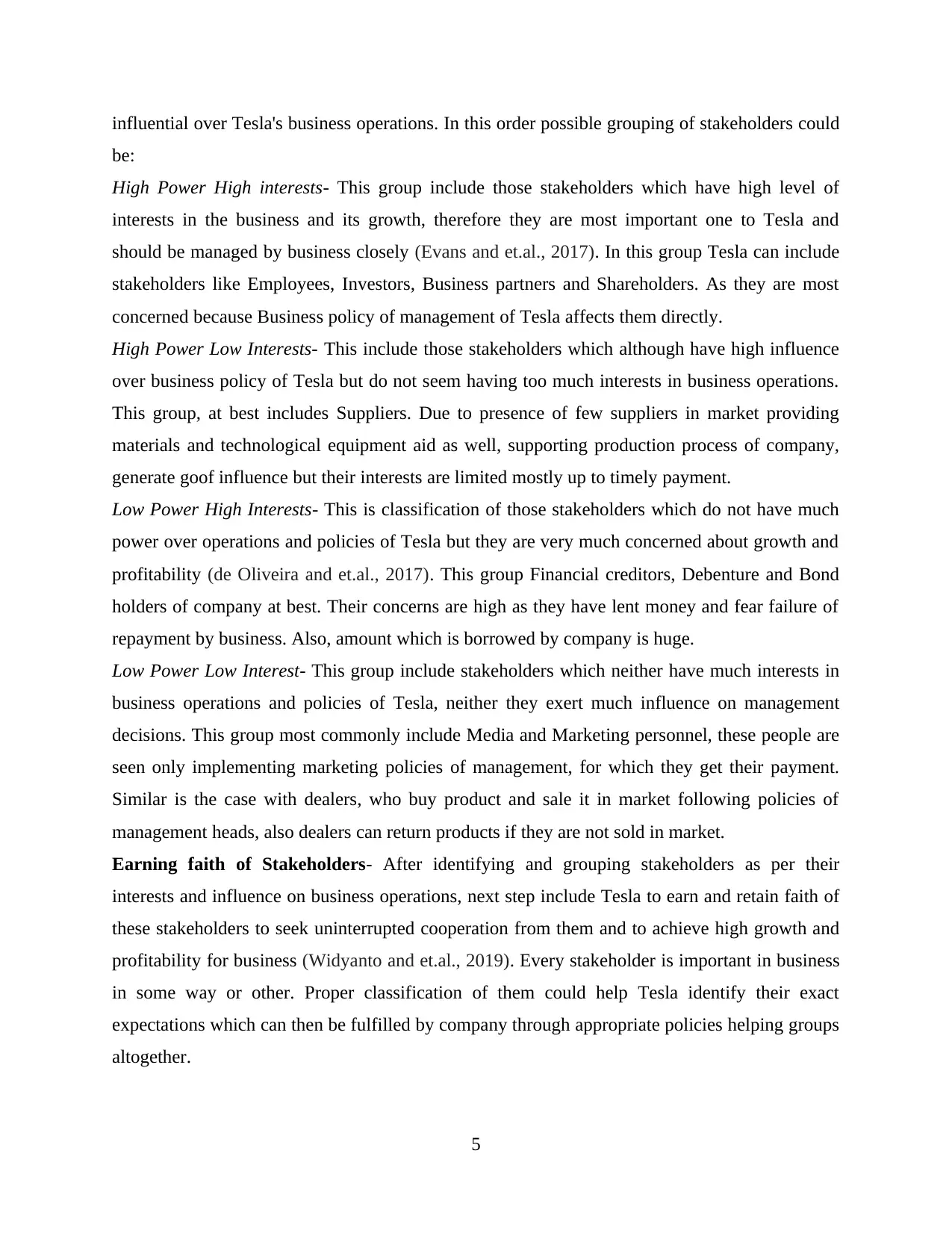
influential over Tesla's business operations. In this order possible grouping of stakeholders could
be:
High Power High interests- This group include those stakeholders which have high level of
interests in the business and its growth, therefore they are most important one to Tesla and
should be managed by business closely (Evans and et.al., 2017). In this group Tesla can include
stakeholders like Employees, Investors, Business partners and Shareholders. As they are most
concerned because Business policy of management of Tesla affects them directly.
High Power Low Interests- This include those stakeholders which although have high influence
over business policy of Tesla but do not seem having too much interests in business operations.
This group, at best includes Suppliers. Due to presence of few suppliers in market providing
materials and technological equipment aid as well, supporting production process of company,
generate goof influence but their interests are limited mostly up to timely payment.
Low Power High Interests- This is classification of those stakeholders which do not have much
power over operations and policies of Tesla but they are very much concerned about growth and
profitability (de Oliveira and et.al., 2017). This group Financial creditors, Debenture and Bond
holders of company at best. Their concerns are high as they have lent money and fear failure of
repayment by business. Also, amount which is borrowed by company is huge.
Low Power Low Interest- This group include stakeholders which neither have much interests in
business operations and policies of Tesla, neither they exert much influence on management
decisions. This group most commonly include Media and Marketing personnel, these people are
seen only implementing marketing policies of management, for which they get their payment.
Similar is the case with dealers, who buy product and sale it in market following policies of
management heads, also dealers can return products if they are not sold in market.
Earning faith of Stakeholders- After identifying and grouping stakeholders as per their
interests and influence on business operations, next step include Tesla to earn and retain faith of
these stakeholders to seek uninterrupted cooperation from them and to achieve high growth and
profitability for business (Widyanto and et.al., 2019). Every stakeholder is important in business
in some way or other. Proper classification of them could help Tesla identify their exact
expectations which can then be fulfilled by company through appropriate policies helping groups
altogether.
5
be:
High Power High interests- This group include those stakeholders which have high level of
interests in the business and its growth, therefore they are most important one to Tesla and
should be managed by business closely (Evans and et.al., 2017). In this group Tesla can include
stakeholders like Employees, Investors, Business partners and Shareholders. As they are most
concerned because Business policy of management of Tesla affects them directly.
High Power Low Interests- This include those stakeholders which although have high influence
over business policy of Tesla but do not seem having too much interests in business operations.
This group, at best includes Suppliers. Due to presence of few suppliers in market providing
materials and technological equipment aid as well, supporting production process of company,
generate goof influence but their interests are limited mostly up to timely payment.
Low Power High Interests- This is classification of those stakeholders which do not have much
power over operations and policies of Tesla but they are very much concerned about growth and
profitability (de Oliveira and et.al., 2017). This group Financial creditors, Debenture and Bond
holders of company at best. Their concerns are high as they have lent money and fear failure of
repayment by business. Also, amount which is borrowed by company is huge.
Low Power Low Interest- This group include stakeholders which neither have much interests in
business operations and policies of Tesla, neither they exert much influence on management
decisions. This group most commonly include Media and Marketing personnel, these people are
seen only implementing marketing policies of management, for which they get their payment.
Similar is the case with dealers, who buy product and sale it in market following policies of
management heads, also dealers can return products if they are not sold in market.
Earning faith of Stakeholders- After identifying and grouping stakeholders as per their
interests and influence on business operations, next step include Tesla to earn and retain faith of
these stakeholders to seek uninterrupted cooperation from them and to achieve high growth and
profitability for business (Widyanto and et.al., 2019). Every stakeholder is important in business
in some way or other. Proper classification of them could help Tesla identify their exact
expectations which can then be fulfilled by company through appropriate policies helping groups
altogether.
5
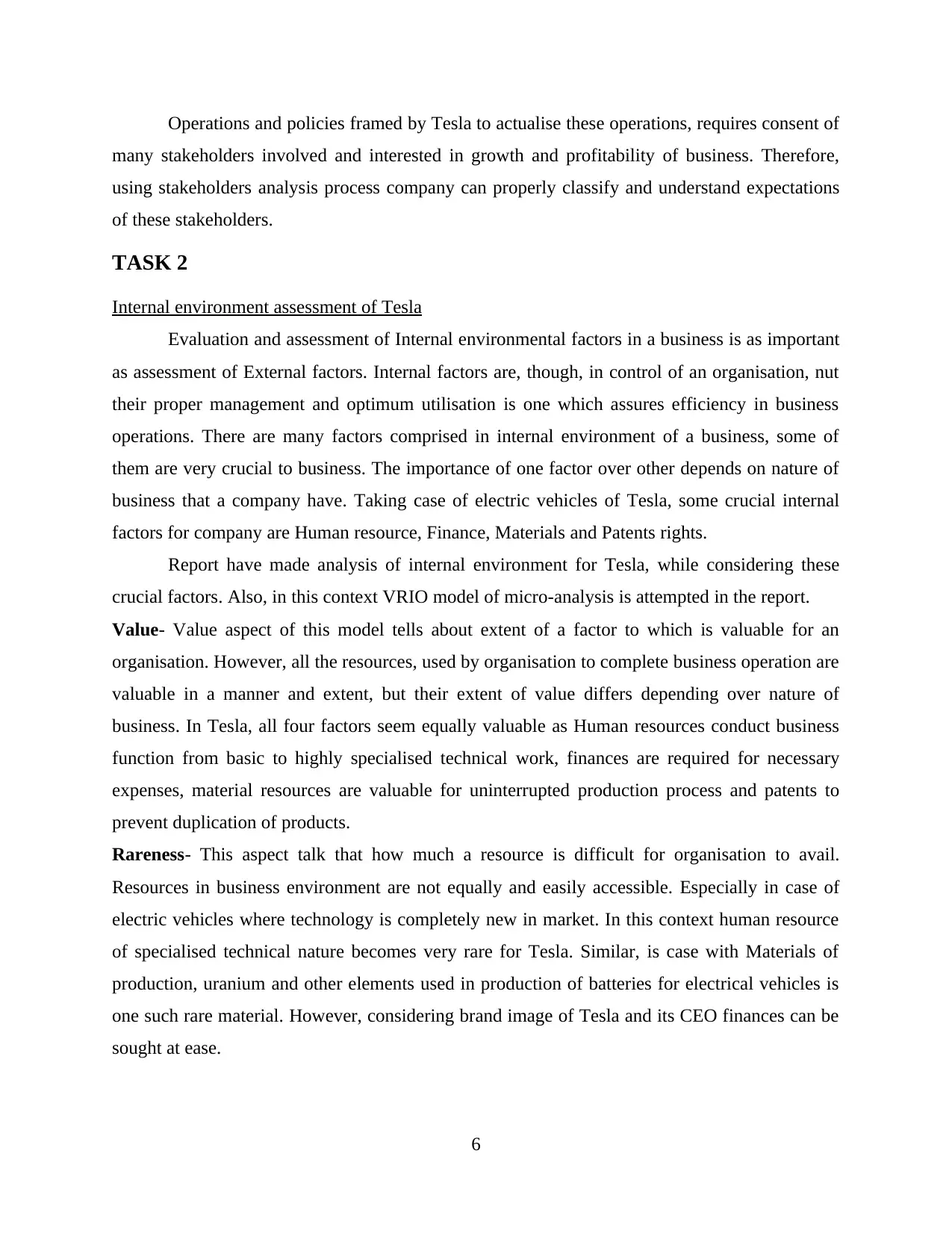
Operations and policies framed by Tesla to actualise these operations, requires consent of
many stakeholders involved and interested in growth and profitability of business. Therefore,
using stakeholders analysis process company can properly classify and understand expectations
of these stakeholders.
TASK 2
Internal environment assessment of Tesla
Evaluation and assessment of Internal environmental factors in a business is as important
as assessment of External factors. Internal factors are, though, in control of an organisation, nut
their proper management and optimum utilisation is one which assures efficiency in business
operations. There are many factors comprised in internal environment of a business, some of
them are very crucial to business. The importance of one factor over other depends on nature of
business that a company have. Taking case of electric vehicles of Tesla, some crucial internal
factors for company are Human resource, Finance, Materials and Patents rights.
Report have made analysis of internal environment for Tesla, while considering these
crucial factors. Also, in this context VRIO model of micro-analysis is attempted in the report.
Value- Value aspect of this model tells about extent of a factor to which is valuable for an
organisation. However, all the resources, used by organisation to complete business operation are
valuable in a manner and extent, but their extent of value differs depending over nature of
business. In Tesla, all four factors seem equally valuable as Human resources conduct business
function from basic to highly specialised technical work, finances are required for necessary
expenses, material resources are valuable for uninterrupted production process and patents to
prevent duplication of products.
Rareness- This aspect talk that how much a resource is difficult for organisation to avail.
Resources in business environment are not equally and easily accessible. Especially in case of
electric vehicles where technology is completely new in market. In this context human resource
of specialised technical nature becomes very rare for Tesla. Similar, is case with Materials of
production, uranium and other elements used in production of batteries for electrical vehicles is
one such rare material. However, considering brand image of Tesla and its CEO finances can be
sought at ease.
6
many stakeholders involved and interested in growth and profitability of business. Therefore,
using stakeholders analysis process company can properly classify and understand expectations
of these stakeholders.
TASK 2
Internal environment assessment of Tesla
Evaluation and assessment of Internal environmental factors in a business is as important
as assessment of External factors. Internal factors are, though, in control of an organisation, nut
their proper management and optimum utilisation is one which assures efficiency in business
operations. There are many factors comprised in internal environment of a business, some of
them are very crucial to business. The importance of one factor over other depends on nature of
business that a company have. Taking case of electric vehicles of Tesla, some crucial internal
factors for company are Human resource, Finance, Materials and Patents rights.
Report have made analysis of internal environment for Tesla, while considering these
crucial factors. Also, in this context VRIO model of micro-analysis is attempted in the report.
Value- Value aspect of this model tells about extent of a factor to which is valuable for an
organisation. However, all the resources, used by organisation to complete business operation are
valuable in a manner and extent, but their extent of value differs depending over nature of
business. In Tesla, all four factors seem equally valuable as Human resources conduct business
function from basic to highly specialised technical work, finances are required for necessary
expenses, material resources are valuable for uninterrupted production process and patents to
prevent duplication of products.
Rareness- This aspect talk that how much a resource is difficult for organisation to avail.
Resources in business environment are not equally and easily accessible. Especially in case of
electric vehicles where technology is completely new in market. In this context human resource
of specialised technical nature becomes very rare for Tesla. Similar, is case with Materials of
production, uranium and other elements used in production of batteries for electrical vehicles is
one such rare material. However, considering brand image of Tesla and its CEO finances can be
sought at ease.
6
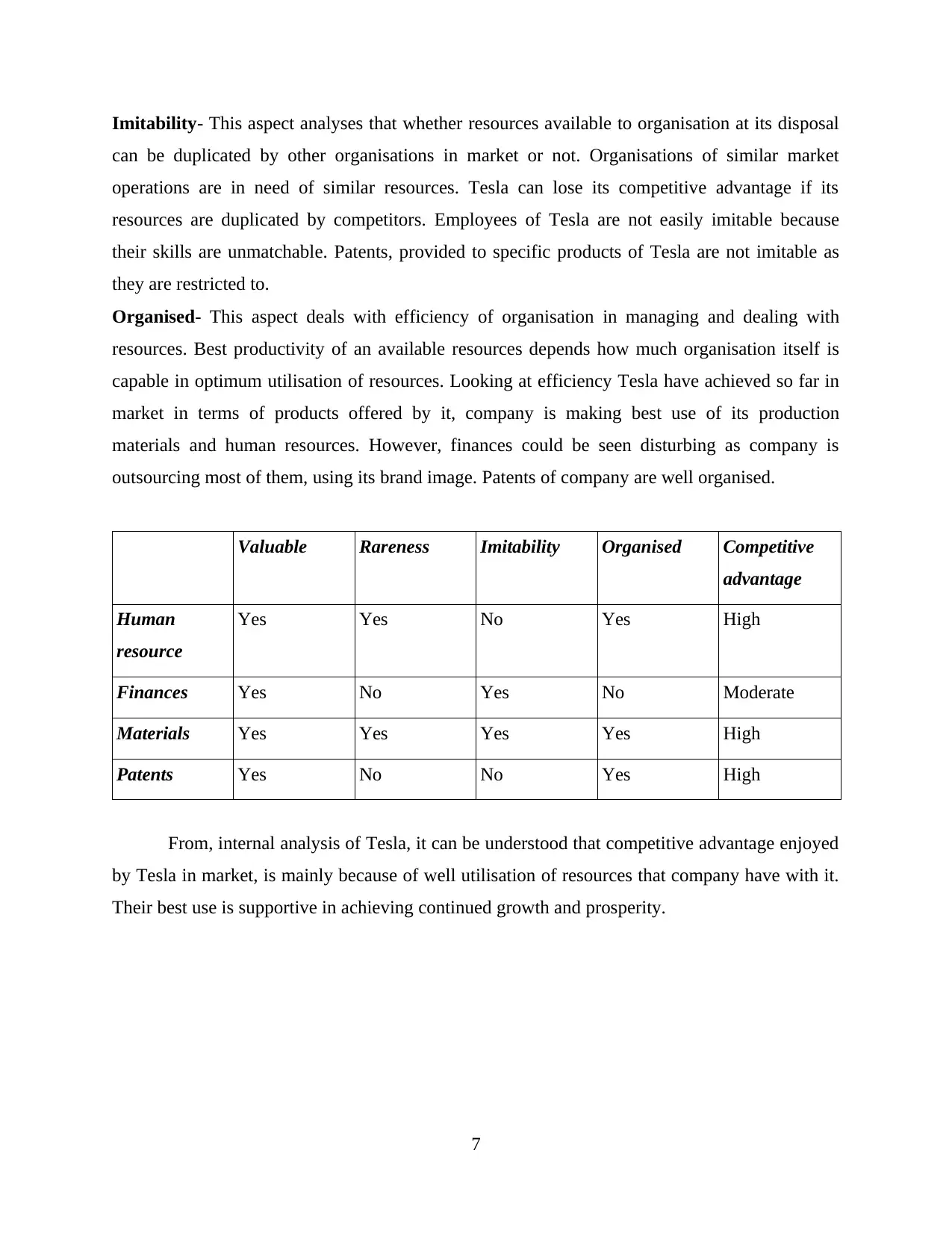
Imitability- This aspect analyses that whether resources available to organisation at its disposal
can be duplicated by other organisations in market or not. Organisations of similar market
operations are in need of similar resources. Tesla can lose its competitive advantage if its
resources are duplicated by competitors. Employees of Tesla are not easily imitable because
their skills are unmatchable. Patents, provided to specific products of Tesla are not imitable as
they are restricted to.
Organised- This aspect deals with efficiency of organisation in managing and dealing with
resources. Best productivity of an available resources depends how much organisation itself is
capable in optimum utilisation of resources. Looking at efficiency Tesla have achieved so far in
market in terms of products offered by it, company is making best use of its production
materials and human resources. However, finances could be seen disturbing as company is
outsourcing most of them, using its brand image. Patents of company are well organised.
Valuable Rareness Imitability Organised Competitive
advantage
Human
resource
Yes Yes No Yes High
Finances Yes No Yes No Moderate
Materials Yes Yes Yes Yes High
Patents Yes No No Yes High
From, internal analysis of Tesla, it can be understood that competitive advantage enjoyed
by Tesla in market, is mainly because of well utilisation of resources that company have with it.
Their best use is supportive in achieving continued growth and prosperity.
7
can be duplicated by other organisations in market or not. Organisations of similar market
operations are in need of similar resources. Tesla can lose its competitive advantage if its
resources are duplicated by competitors. Employees of Tesla are not easily imitable because
their skills are unmatchable. Patents, provided to specific products of Tesla are not imitable as
they are restricted to.
Organised- This aspect deals with efficiency of organisation in managing and dealing with
resources. Best productivity of an available resources depends how much organisation itself is
capable in optimum utilisation of resources. Looking at efficiency Tesla have achieved so far in
market in terms of products offered by it, company is making best use of its production
materials and human resources. However, finances could be seen disturbing as company is
outsourcing most of them, using its brand image. Patents of company are well organised.
Valuable Rareness Imitability Organised Competitive
advantage
Human
resource
Yes Yes No Yes High
Finances Yes No Yes No Moderate
Materials Yes Yes Yes Yes High
Patents Yes No No Yes High
From, internal analysis of Tesla, it can be understood that competitive advantage enjoyed
by Tesla in market, is mainly because of well utilisation of resources that company have with it.
Their best use is supportive in achieving continued growth and prosperity.
7
Secure Best Marks with AI Grader
Need help grading? Try our AI Grader for instant feedback on your assignments.
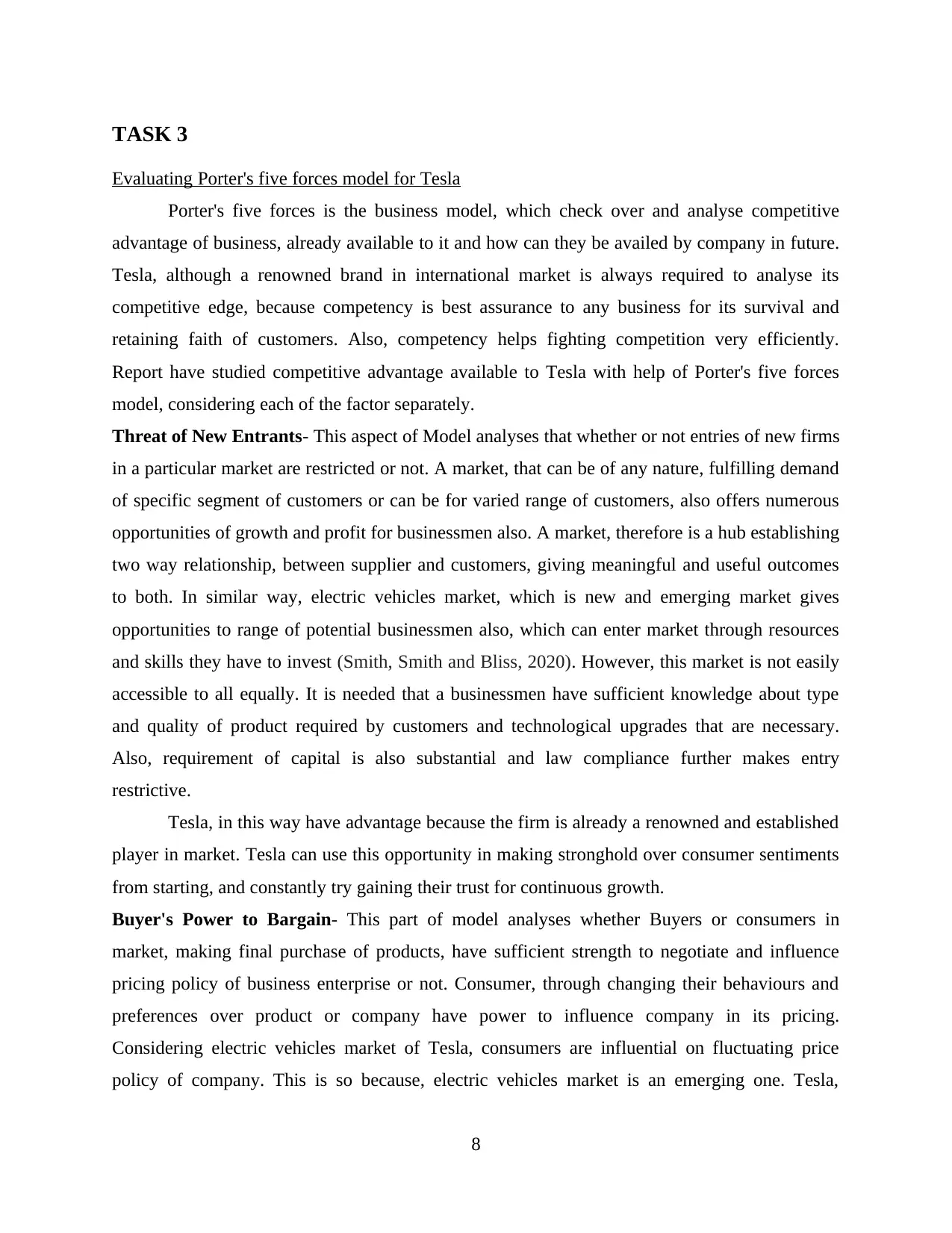
TASK 3
Evaluating Porter's five forces model for Tesla
Porter's five forces is the business model, which check over and analyse competitive
advantage of business, already available to it and how can they be availed by company in future.
Tesla, although a renowned brand in international market is always required to analyse its
competitive edge, because competency is best assurance to any business for its survival and
retaining faith of customers. Also, competency helps fighting competition very efficiently.
Report have studied competitive advantage available to Tesla with help of Porter's five forces
model, considering each of the factor separately.
Threat of New Entrants- This aspect of Model analyses that whether or not entries of new firms
in a particular market are restricted or not. A market, that can be of any nature, fulfilling demand
of specific segment of customers or can be for varied range of customers, also offers numerous
opportunities of growth and profit for businessmen also. A market, therefore is a hub establishing
two way relationship, between supplier and customers, giving meaningful and useful outcomes
to both. In similar way, electric vehicles market, which is new and emerging market gives
opportunities to range of potential businessmen also, which can enter market through resources
and skills they have to invest (Smith, Smith and Bliss, 2020). However, this market is not easily
accessible to all equally. It is needed that a businessmen have sufficient knowledge about type
and quality of product required by customers and technological upgrades that are necessary.
Also, requirement of capital is also substantial and law compliance further makes entry
restrictive.
Tesla, in this way have advantage because the firm is already a renowned and established
player in market. Tesla can use this opportunity in making stronghold over consumer sentiments
from starting, and constantly try gaining their trust for continuous growth.
Buyer's Power to Bargain- This part of model analyses whether Buyers or consumers in
market, making final purchase of products, have sufficient strength to negotiate and influence
pricing policy of business enterprise or not. Consumer, through changing their behaviours and
preferences over product or company have power to influence company in its pricing.
Considering electric vehicles market of Tesla, consumers are influential on fluctuating price
policy of company. This is so because, electric vehicles market is an emerging one. Tesla,
8
Evaluating Porter's five forces model for Tesla
Porter's five forces is the business model, which check over and analyse competitive
advantage of business, already available to it and how can they be availed by company in future.
Tesla, although a renowned brand in international market is always required to analyse its
competitive edge, because competency is best assurance to any business for its survival and
retaining faith of customers. Also, competency helps fighting competition very efficiently.
Report have studied competitive advantage available to Tesla with help of Porter's five forces
model, considering each of the factor separately.
Threat of New Entrants- This aspect of Model analyses that whether or not entries of new firms
in a particular market are restricted or not. A market, that can be of any nature, fulfilling demand
of specific segment of customers or can be for varied range of customers, also offers numerous
opportunities of growth and profit for businessmen also. A market, therefore is a hub establishing
two way relationship, between supplier and customers, giving meaningful and useful outcomes
to both. In similar way, electric vehicles market, which is new and emerging market gives
opportunities to range of potential businessmen also, which can enter market through resources
and skills they have to invest (Smith, Smith and Bliss, 2020). However, this market is not easily
accessible to all equally. It is needed that a businessmen have sufficient knowledge about type
and quality of product required by customers and technological upgrades that are necessary.
Also, requirement of capital is also substantial and law compliance further makes entry
restrictive.
Tesla, in this way have advantage because the firm is already a renowned and established
player in market. Tesla can use this opportunity in making stronghold over consumer sentiments
from starting, and constantly try gaining their trust for continuous growth.
Buyer's Power to Bargain- This part of model analyses whether Buyers or consumers in
market, making final purchase of products, have sufficient strength to negotiate and influence
pricing policy of business enterprise or not. Consumer, through changing their behaviours and
preferences over product or company have power to influence company in its pricing.
Considering electric vehicles market of Tesla, consumers are influential on fluctuating price
policy of company. This is so because, electric vehicles market is an emerging one. Tesla,
8

although a big player, still have to ,convince customers for choosing clean energy vehicles over
traditional vehicles. Therefore, unless consumers gets significantly shifted towards electric
vehicles, Tesla is required to make policies in accordance with customers, for attracting and
inciting them for its products.
Suppliers' Power to Bargain- This aspect, similar to above part, analyses about power of
Suppliers in industry are influential over interfering in pricing policy, which offer range of raw
materials and other equipments helping in production activities of company. Production is most
significant part of business operations. Without production business will have no products to
offer in market and would be unable to earn revenue. For Tesla, business have to deal in variety
of suppliers, which not only supplies raw products but also technologically finished products like
lithium ion batteries and updated engines of vehicles. Range of suppliers in this field are very
few, which deal with multiple electric vehicles company, not as big as Tesla but aspire to capture
market.
Hence of power of supplier to negotiate can be considered as moderate in this context
because even if there are fewer suppliers in market but Tesla makes significant procurement
from them. Therefore, it is required for company to build long term relations with its suppliers by
following policy of negotiations.
Threat of Substitution- This part of model analyses availability of substitute products for
products offered by company in market and chances of customers to easily switch over them.
Considering substitutes of electric vehicles in market, traditional petrol, diesel and gas vehicles
can threaten competitive advantage enjoyed by Tesla.
In case, Tesla do not remain flexible in policies for attracting customers and to establish
its stronghold over market, customers can easily switch to products which they are using
traditionally. Electric vehicles are emerging products in markets across the world and Tesla still
need to convince customers for achieving growth and fulfil its vision of zero-emission vehicles
used by each and everyone.
Competitive rivalry- This aspect is an analysis of rivalry and stiff competition posed by
competitive players in Market. Although there are not many players in market of electric
vehicles neither it is easy to enter market, get established and wipe consumers. But even those
few players have big aspirations and are constantly changing their policies and practices to get
influential and consolidate market.
9
traditional vehicles. Therefore, unless consumers gets significantly shifted towards electric
vehicles, Tesla is required to make policies in accordance with customers, for attracting and
inciting them for its products.
Suppliers' Power to Bargain- This aspect, similar to above part, analyses about power of
Suppliers in industry are influential over interfering in pricing policy, which offer range of raw
materials and other equipments helping in production activities of company. Production is most
significant part of business operations. Without production business will have no products to
offer in market and would be unable to earn revenue. For Tesla, business have to deal in variety
of suppliers, which not only supplies raw products but also technologically finished products like
lithium ion batteries and updated engines of vehicles. Range of suppliers in this field are very
few, which deal with multiple electric vehicles company, not as big as Tesla but aspire to capture
market.
Hence of power of supplier to negotiate can be considered as moderate in this context
because even if there are fewer suppliers in market but Tesla makes significant procurement
from them. Therefore, it is required for company to build long term relations with its suppliers by
following policy of negotiations.
Threat of Substitution- This part of model analyses availability of substitute products for
products offered by company in market and chances of customers to easily switch over them.
Considering substitutes of electric vehicles in market, traditional petrol, diesel and gas vehicles
can threaten competitive advantage enjoyed by Tesla.
In case, Tesla do not remain flexible in policies for attracting customers and to establish
its stronghold over market, customers can easily switch to products which they are using
traditionally. Electric vehicles are emerging products in markets across the world and Tesla still
need to convince customers for achieving growth and fulfil its vision of zero-emission vehicles
used by each and everyone.
Competitive rivalry- This aspect is an analysis of rivalry and stiff competition posed by
competitive players in Market. Although there are not many players in market of electric
vehicles neither it is easy to enter market, get established and wipe consumers. But even those
few players have big aspirations and are constantly changing their policies and practices to get
influential and consolidate market.
9
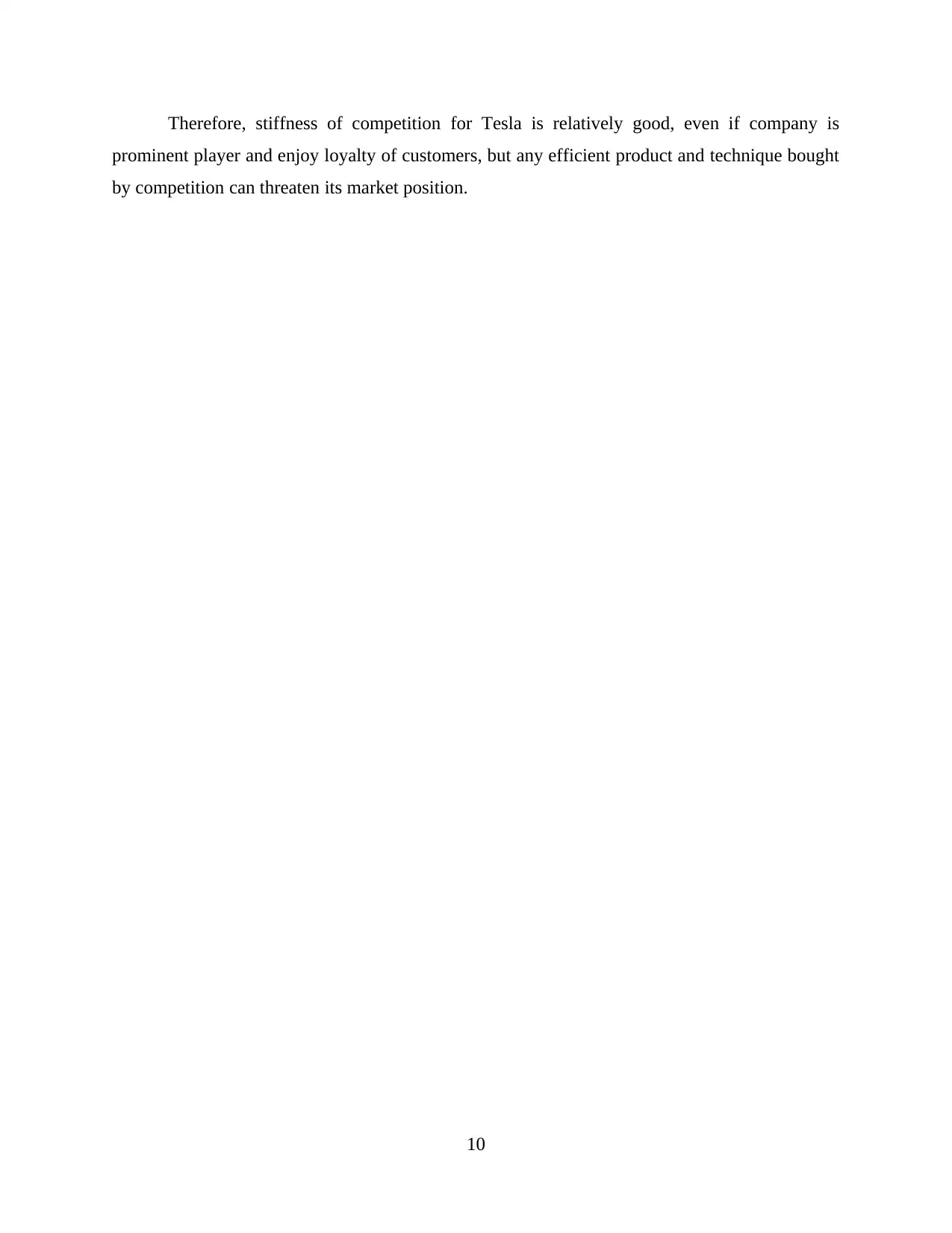
Therefore, stiffness of competition for Tesla is relatively good, even if company is
prominent player and enjoy loyalty of customers, but any efficient product and technique bought
by competition can threaten its market position.
10
prominent player and enjoy loyalty of customers, but any efficient product and technique bought
by competition can threaten its market position.
10
Paraphrase This Document
Need a fresh take? Get an instant paraphrase of this document with our AI Paraphraser

TASK 4
Devising Strategic planning for Tesla
Strategic plan is a broad based and wide plan of any business which is formulated in
meeting as well as forecasting current as well as future needs of an organisation. The plan cover
s almost al aspect, dimensions and factors pertaining to a business organisation. Strategic plans
are mostly formulated with eyeing on fulfilling vision and objectives of organisation which it
aspire for fulfilling in long run (Seifzadeh and Rowe, 2019). Strategic planning also helps
organisation in making optimum utilisation of resources available as well as make prediction of
future needs of resources.
For purpose of devising a strategic plan for Tesla, helping company to fulfil its vision
while catering current and future needs of organisation, the report have used two most
appropriate models in this context.
Bowman's Strategic clock
Bowman's strategic clock is tool to strategically analyse and position a business in
competitive advantage in market. This model list out different competitive positions available to
a market as it achieves more growth with time and analyses affects of these situations on
business. At different position Tesla is required to formulate suitable strategies.
Low price and Low value added- In this position product of company are seen like chips, low
price and low value. This not advantageous position for Tesla because customers here finds no
values in products.
Low Price- In this position prices of products are kept low. This can be a little strategic position
for Tesla in attracting customers and increase sales.
Hybrid- This is position where company uses some elements of low prices and some elements of
product differentiation. This position can be strategically crucial for Tesla where low price will
attract customers and product differentiation will help in perceiving value of products.
Differentiation- Under this position Tesla can opt making high quality value and quality addition
in products of high perceived value in market. This will help in securing competitive edge in
long run for these products.
11
Devising Strategic planning for Tesla
Strategic plan is a broad based and wide plan of any business which is formulated in
meeting as well as forecasting current as well as future needs of an organisation. The plan cover
s almost al aspect, dimensions and factors pertaining to a business organisation. Strategic plans
are mostly formulated with eyeing on fulfilling vision and objectives of organisation which it
aspire for fulfilling in long run (Seifzadeh and Rowe, 2019). Strategic planning also helps
organisation in making optimum utilisation of resources available as well as make prediction of
future needs of resources.
For purpose of devising a strategic plan for Tesla, helping company to fulfil its vision
while catering current and future needs of organisation, the report have used two most
appropriate models in this context.
Bowman's Strategic clock
Bowman's strategic clock is tool to strategically analyse and position a business in
competitive advantage in market. This model list out different competitive positions available to
a market as it achieves more growth with time and analyses affects of these situations on
business. At different position Tesla is required to formulate suitable strategies.
Low price and Low value added- In this position product of company are seen like chips, low
price and low value. This not advantageous position for Tesla because customers here finds no
values in products.
Low Price- In this position prices of products are kept low. This can be a little strategic position
for Tesla in attracting customers and increase sales.
Hybrid- This is position where company uses some elements of low prices and some elements of
product differentiation. This position can be strategically crucial for Tesla where low price will
attract customers and product differentiation will help in perceiving value of products.
Differentiation- Under this position Tesla can opt making high quality value and quality addition
in products of high perceived value in market. This will help in securing competitive edge in
long run for these products.
11
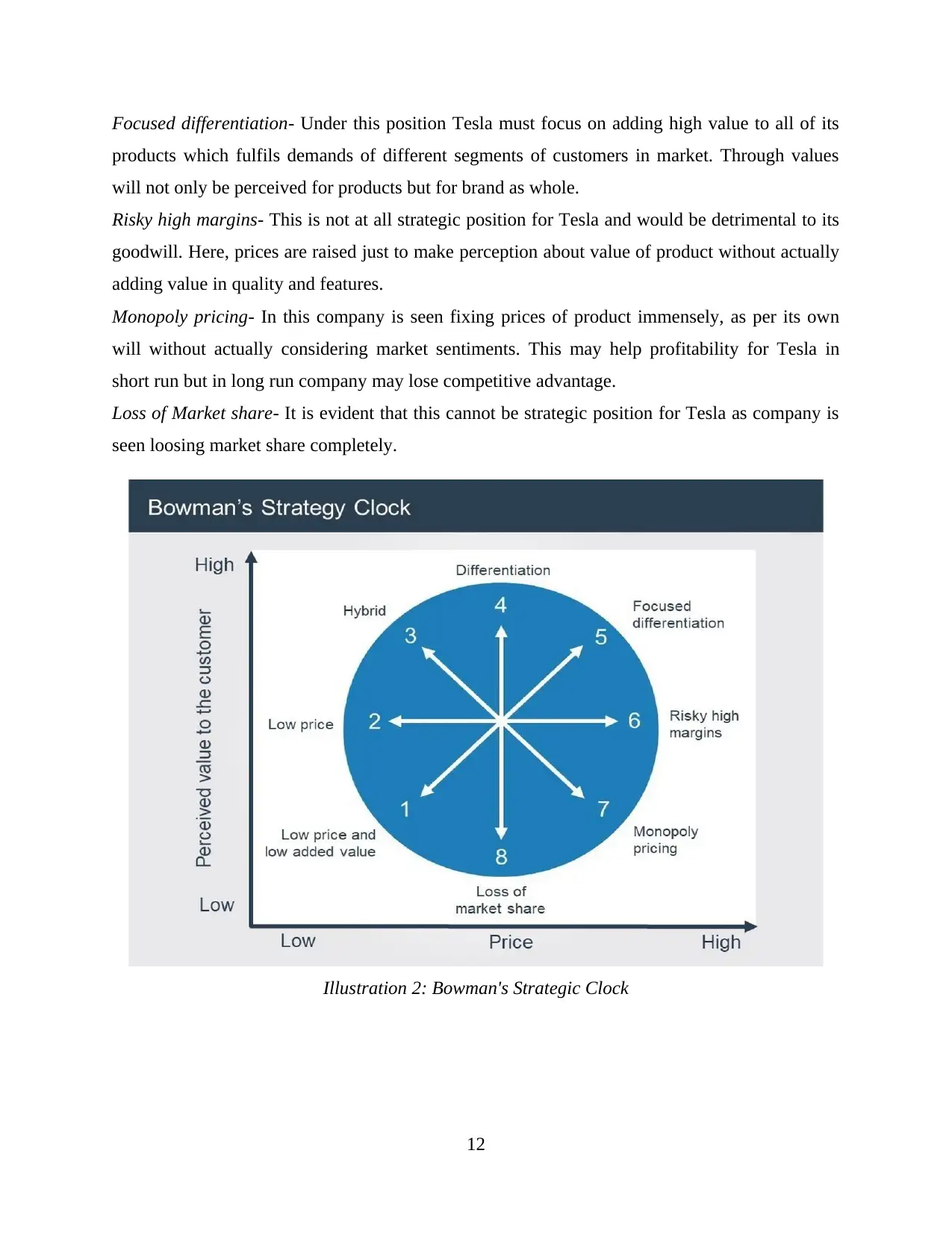
Focused differentiation- Under this position Tesla must focus on adding high value to all of its
products which fulfils demands of different segments of customers in market. Through values
will not only be perceived for products but for brand as whole.
Risky high margins- This is not at all strategic position for Tesla and would be detrimental to its
goodwill. Here, prices are raised just to make perception about value of product without actually
adding value in quality and features.
Monopoly pricing- In this company is seen fixing prices of product immensely, as per its own
will without actually considering market sentiments. This may help profitability for Tesla in
short run but in long run company may lose competitive advantage.
Loss of Market share- It is evident that this cannot be strategic position for Tesla as company is
seen loosing market share completely.
12
Illustration 2: Bowman's Strategic Clock
products which fulfils demands of different segments of customers in market. Through values
will not only be perceived for products but for brand as whole.
Risky high margins- This is not at all strategic position for Tesla and would be detrimental to its
goodwill. Here, prices are raised just to make perception about value of product without actually
adding value in quality and features.
Monopoly pricing- In this company is seen fixing prices of product immensely, as per its own
will without actually considering market sentiments. This may help profitability for Tesla in
short run but in long run company may lose competitive advantage.
Loss of Market share- It is evident that this cannot be strategic position for Tesla as company is
seen loosing market share completely.
12
Illustration 2: Bowman's Strategic Clock
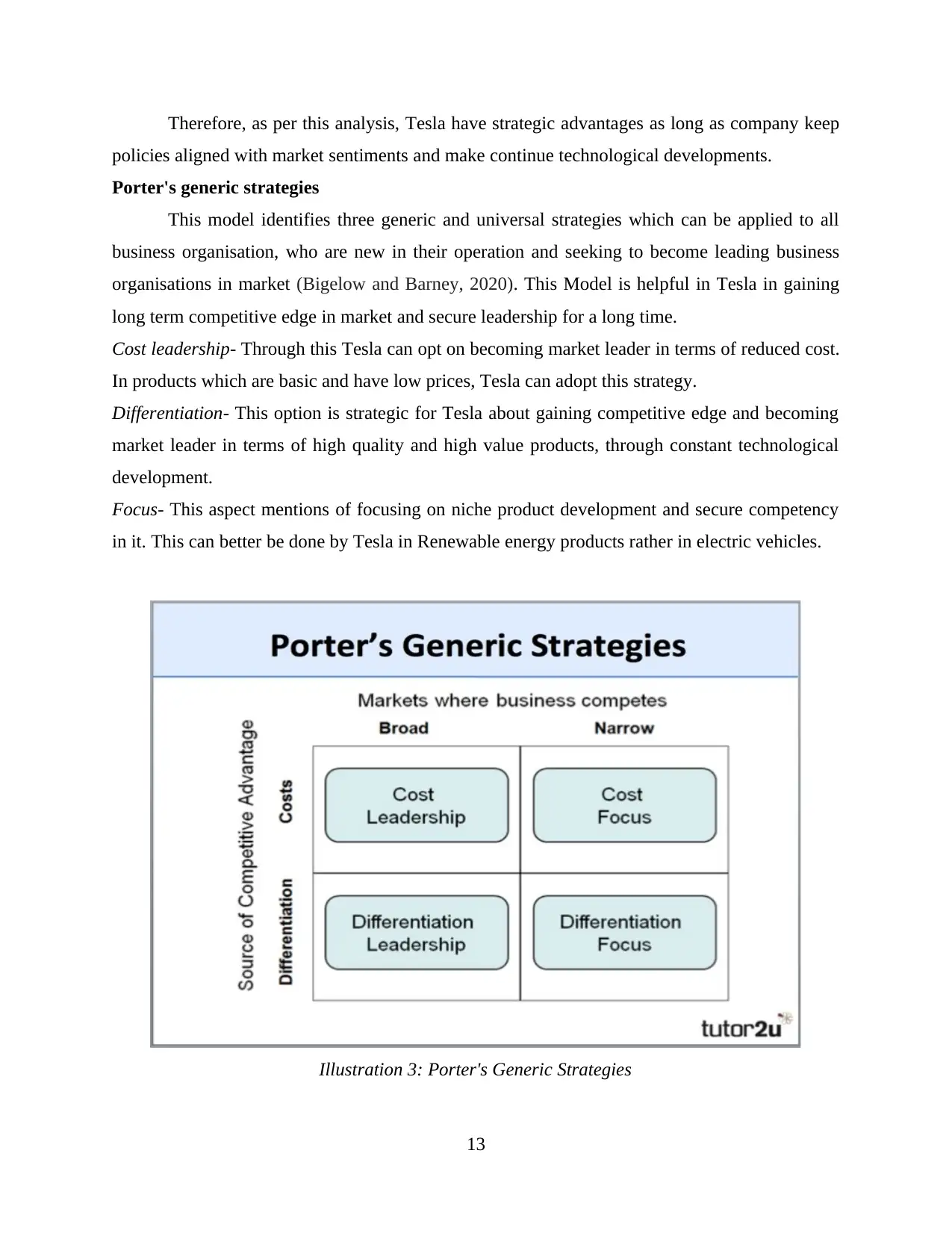
Therefore, as per this analysis, Tesla have strategic advantages as long as company keep
policies aligned with market sentiments and make continue technological developments.
Porter's generic strategies
This model identifies three generic and universal strategies which can be applied to all
business organisation, who are new in their operation and seeking to become leading business
organisations in market (Bigelow and Barney, 2020). This Model is helpful in Tesla in gaining
long term competitive edge in market and secure leadership for a long time.
Cost leadership- Through this Tesla can opt on becoming market leader in terms of reduced cost.
In products which are basic and have low prices, Tesla can adopt this strategy.
Differentiation- This option is strategic for Tesla about gaining competitive edge and becoming
market leader in terms of high quality and high value products, through constant technological
development.
Focus- This aspect mentions of focusing on niche product development and secure competency
in it. This can better be done by Tesla in Renewable energy products rather in electric vehicles.
13
Illustration 3: Porter's Generic Strategies
policies aligned with market sentiments and make continue technological developments.
Porter's generic strategies
This model identifies three generic and universal strategies which can be applied to all
business organisation, who are new in their operation and seeking to become leading business
organisations in market (Bigelow and Barney, 2020). This Model is helpful in Tesla in gaining
long term competitive edge in market and secure leadership for a long time.
Cost leadership- Through this Tesla can opt on becoming market leader in terms of reduced cost.
In products which are basic and have low prices, Tesla can adopt this strategy.
Differentiation- This option is strategic for Tesla about gaining competitive edge and becoming
market leader in terms of high quality and high value products, through constant technological
development.
Focus- This aspect mentions of focusing on niche product development and secure competency
in it. This can better be done by Tesla in Renewable energy products rather in electric vehicles.
13
Illustration 3: Porter's Generic Strategies
Secure Best Marks with AI Grader
Need help grading? Try our AI Grader for instant feedback on your assignments.

Thus, strategic planning through this tool will help Tesla in not only attaining competitive
edge but become leader in market with support of these strategies.
14
edge but become leader in market with support of these strategies.
14
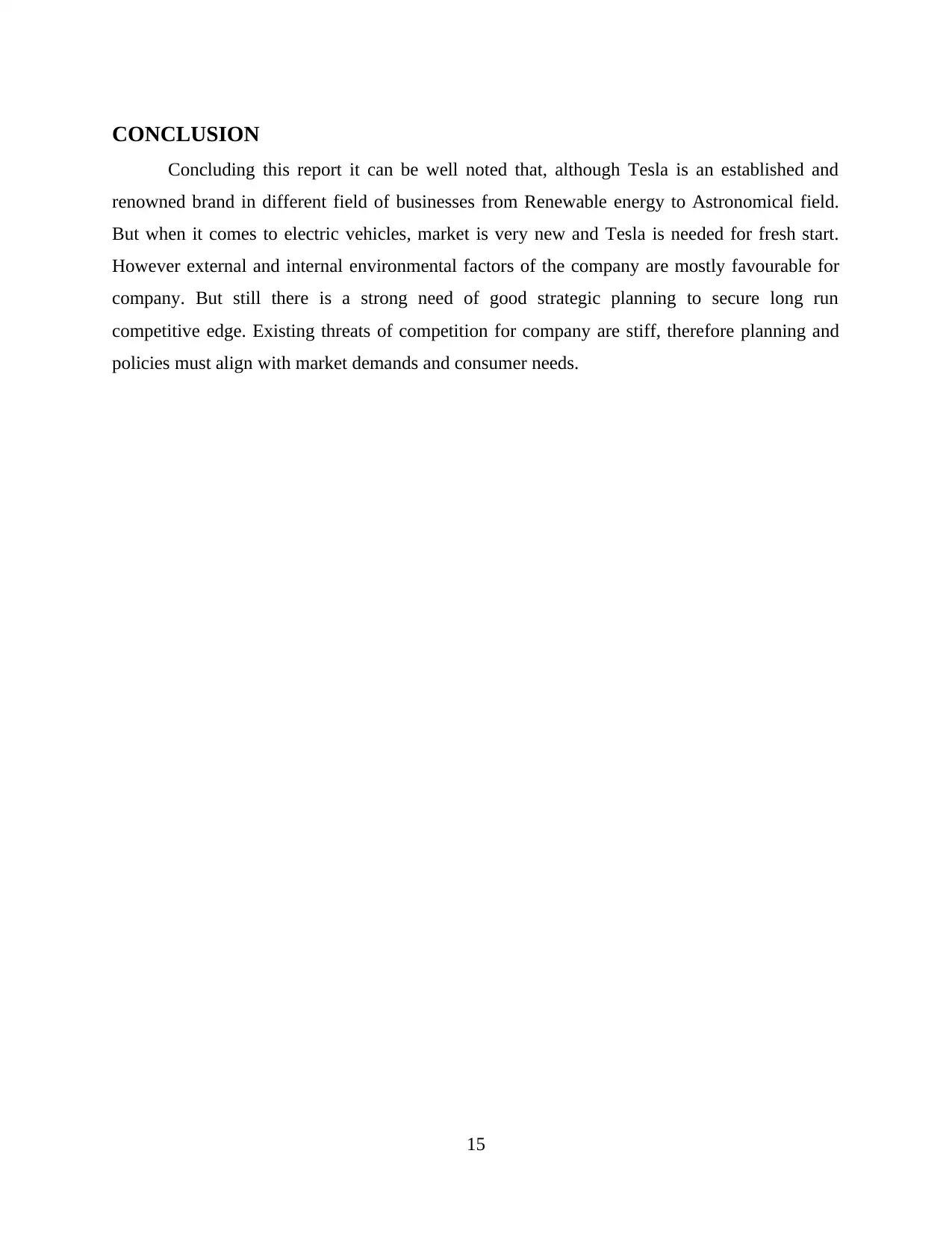
CONCLUSION
Concluding this report it can be well noted that, although Tesla is an established and
renowned brand in different field of businesses from Renewable energy to Astronomical field.
But when it comes to electric vehicles, market is very new and Tesla is needed for fresh start.
However external and internal environmental factors of the company are mostly favourable for
company. But still there is a strong need of good strategic planning to secure long run
competitive edge. Existing threats of competition for company are stiff, therefore planning and
policies must align with market demands and consumer needs.
15
Concluding this report it can be well noted that, although Tesla is an established and
renowned brand in different field of businesses from Renewable energy to Astronomical field.
But when it comes to electric vehicles, market is very new and Tesla is needed for fresh start.
However external and internal environmental factors of the company are mostly favourable for
company. But still there is a strong need of good strategic planning to secure long run
competitive edge. Existing threats of competition for company are stiff, therefore planning and
policies must align with market demands and consumer needs.
15
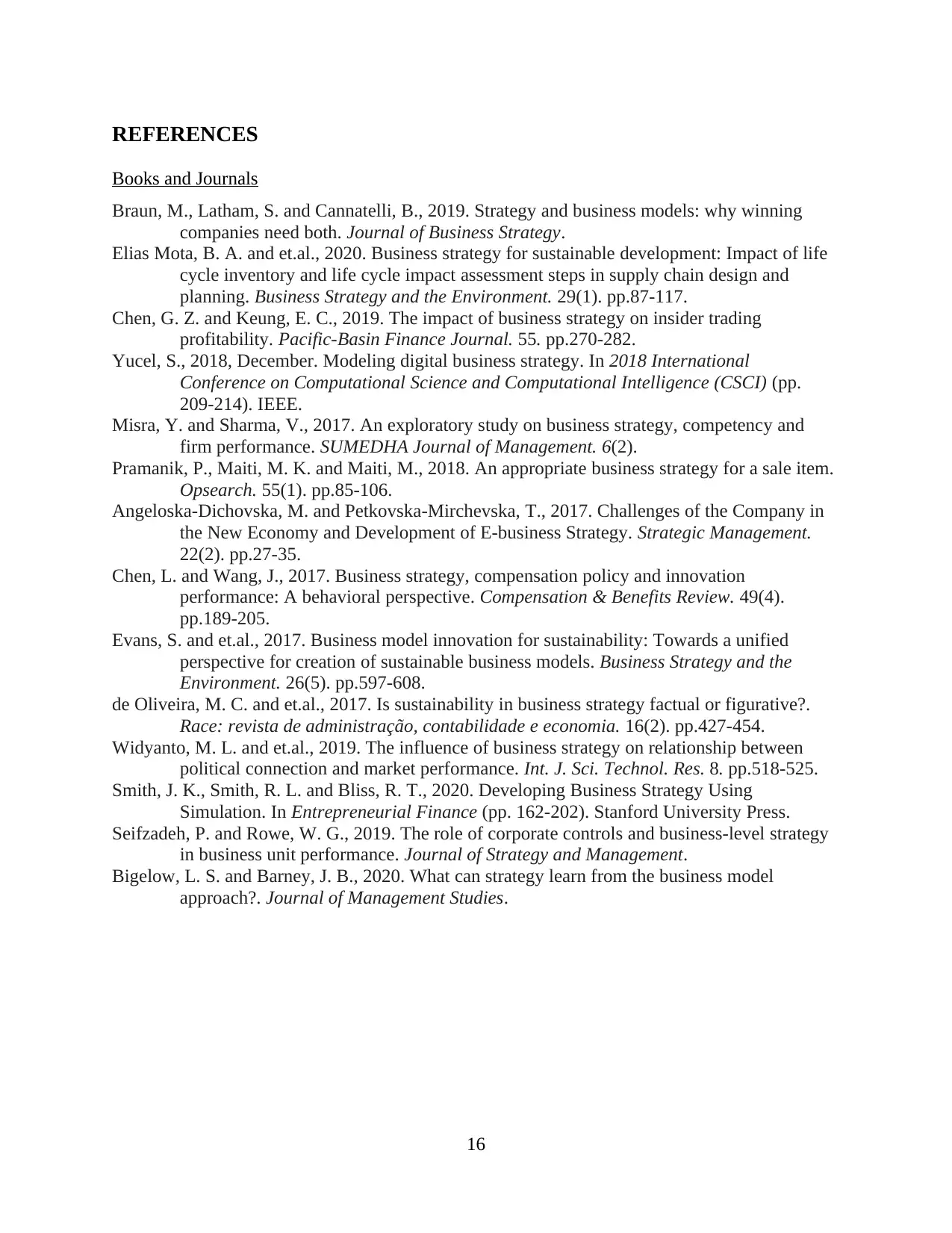
REFERENCES
Books and Journals
Braun, M., Latham, S. and Cannatelli, B., 2019. Strategy and business models: why winning
companies need both. Journal of Business Strategy.
Elias Mota, B. A. and et.al., 2020. Business strategy for sustainable development: Impact of life
cycle inventory and life cycle impact assessment steps in supply chain design and
planning. Business Strategy and the Environment. 29(1). pp.87-117.
Chen, G. Z. and Keung, E. C., 2019. The impact of business strategy on insider trading
profitability. Pacific-Basin Finance Journal. 55. pp.270-282.
Yucel, S., 2018, December. Modeling digital business strategy. In 2018 International
Conference on Computational Science and Computational Intelligence (CSCI) (pp.
209-214). IEEE.
Misra, Y. and Sharma, V., 2017. An exploratory study on business strategy, competency and
firm performance. SUMEDHA Journal of Management. 6(2).
Pramanik, P., Maiti, M. K. and Maiti, M., 2018. An appropriate business strategy for a sale item.
Opsearch. 55(1). pp.85-106.
Angeloska-Dichovska, M. and Petkovska-Mirchevska, T., 2017. Challenges of the Company in
the New Economy and Development of E-business Strategy. Strategic Management.
22(2). pp.27-35.
Chen, L. and Wang, J., 2017. Business strategy, compensation policy and innovation
performance: A behavioral perspective. Compensation & Benefits Review. 49(4).
pp.189-205.
Evans, S. and et.al., 2017. Business model innovation for sustainability: Towards a unified
perspective for creation of sustainable business models. Business Strategy and the
Environment. 26(5). pp.597-608.
de Oliveira, M. C. and et.al., 2017. Is sustainability in business strategy factual or figurative?.
Race: revista de administração, contabilidade e economia. 16(2). pp.427-454.
Widyanto, M. L. and et.al., 2019. The influence of business strategy on relationship between
political connection and market performance. Int. J. Sci. Technol. Res. 8. pp.518-525.
Smith, J. K., Smith, R. L. and Bliss, R. T., 2020. Developing Business Strategy Using
Simulation. In Entrepreneurial Finance (pp. 162-202). Stanford University Press.
Seifzadeh, P. and Rowe, W. G., 2019. The role of corporate controls and business-level strategy
in business unit performance. Journal of Strategy and Management.
Bigelow, L. S. and Barney, J. B., 2020. What can strategy learn from the business model
approach?. Journal of Management Studies.
16
Books and Journals
Braun, M., Latham, S. and Cannatelli, B., 2019. Strategy and business models: why winning
companies need both. Journal of Business Strategy.
Elias Mota, B. A. and et.al., 2020. Business strategy for sustainable development: Impact of life
cycle inventory and life cycle impact assessment steps in supply chain design and
planning. Business Strategy and the Environment. 29(1). pp.87-117.
Chen, G. Z. and Keung, E. C., 2019. The impact of business strategy on insider trading
profitability. Pacific-Basin Finance Journal. 55. pp.270-282.
Yucel, S., 2018, December. Modeling digital business strategy. In 2018 International
Conference on Computational Science and Computational Intelligence (CSCI) (pp.
209-214). IEEE.
Misra, Y. and Sharma, V., 2017. An exploratory study on business strategy, competency and
firm performance. SUMEDHA Journal of Management. 6(2).
Pramanik, P., Maiti, M. K. and Maiti, M., 2018. An appropriate business strategy for a sale item.
Opsearch. 55(1). pp.85-106.
Angeloska-Dichovska, M. and Petkovska-Mirchevska, T., 2017. Challenges of the Company in
the New Economy and Development of E-business Strategy. Strategic Management.
22(2). pp.27-35.
Chen, L. and Wang, J., 2017. Business strategy, compensation policy and innovation
performance: A behavioral perspective. Compensation & Benefits Review. 49(4).
pp.189-205.
Evans, S. and et.al., 2017. Business model innovation for sustainability: Towards a unified
perspective for creation of sustainable business models. Business Strategy and the
Environment. 26(5). pp.597-608.
de Oliveira, M. C. and et.al., 2017. Is sustainability in business strategy factual or figurative?.
Race: revista de administração, contabilidade e economia. 16(2). pp.427-454.
Widyanto, M. L. and et.al., 2019. The influence of business strategy on relationship between
political connection and market performance. Int. J. Sci. Technol. Res. 8. pp.518-525.
Smith, J. K., Smith, R. L. and Bliss, R. T., 2020. Developing Business Strategy Using
Simulation. In Entrepreneurial Finance (pp. 162-202). Stanford University Press.
Seifzadeh, P. and Rowe, W. G., 2019. The role of corporate controls and business-level strategy
in business unit performance. Journal of Strategy and Management.
Bigelow, L. S. and Barney, J. B., 2020. What can strategy learn from the business model
approach?. Journal of Management Studies.
16
1 out of 19
Related Documents
Your All-in-One AI-Powered Toolkit for Academic Success.
+13062052269
info@desklib.com
Available 24*7 on WhatsApp / Email
![[object Object]](/_next/static/media/star-bottom.7253800d.svg)
Unlock your academic potential
© 2024 | Zucol Services PVT LTD | All rights reserved.





